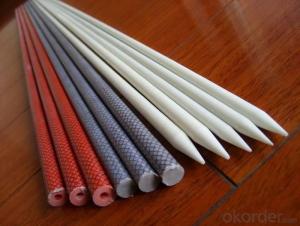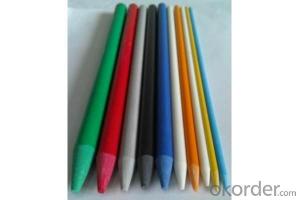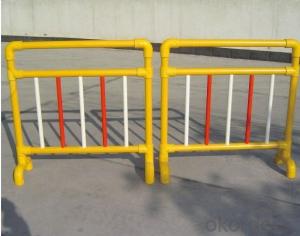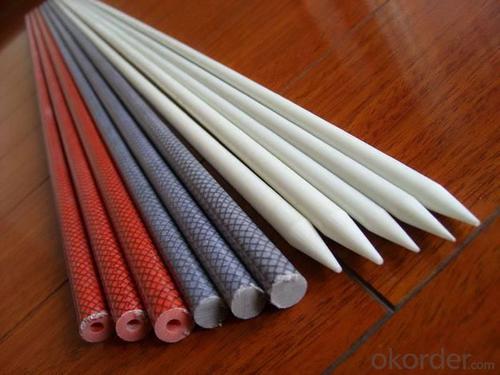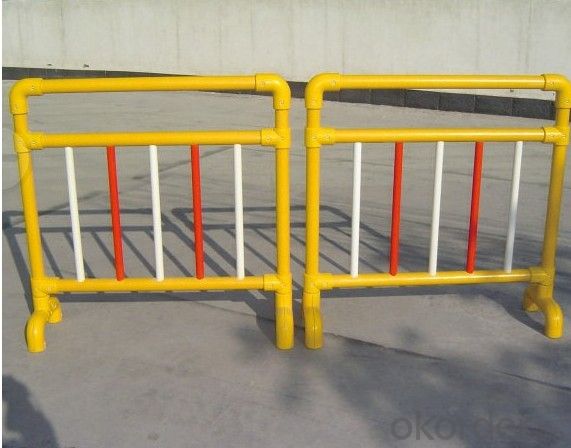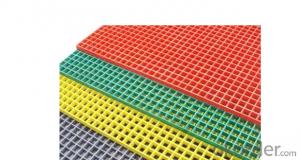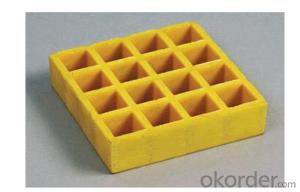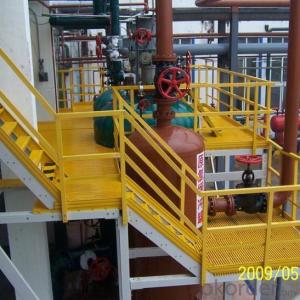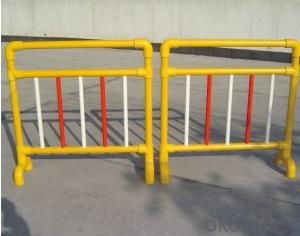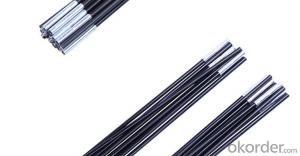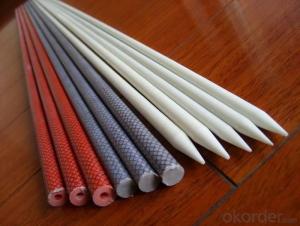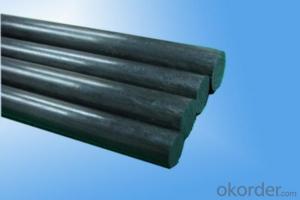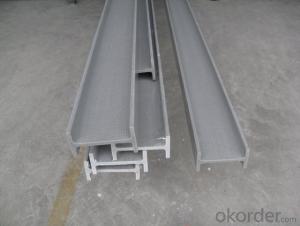FRP Pultrusion Profiles - Flexible Fiberglass Stick with Good Characteristics
- Loading Port:
- China Main Port
- Payment Terms:
- TT OR LC
- Min Order Qty:
- -
- Supply Capability:
- -
OKorder Service Pledge
OKorder Financial Service
You Might Also Like
Features of Flexible Fiberglass Stick with GoodCharacteristics:
Corrosion resistant
High strength & light weight
Long service life
Fire retardant
Impact resistant
Nonconductive and thermal insulation
Non-magnetic electromagnetic transparency
Dimensional stability, Bright color
Low-maintenance
Application of Flexible Fiberglass Stick with Good Characteristics:
1) Outdoor activities: tent Pole, kite Rod,arrow shaft, ski pole, fishing rod, golf shaft, sail batten,hockey stick, kickboard, skate boards, paddle shafts, bows and arrows, crossbows, golf shafts,slideguides, boat, kayak
2) Tool: umbrella shaft, umbrella rod, curtain rod,fence post, rail, handrail, frame for cases andbags, flag pole, oil suckerrods, bolts, stair, ladder, greenhouse structures, scaffold, portable workplatforms, cooling tower, luggage rack, window/door frame, sign post, bridgestructure,bus bar supports, tool handles, bike flags, flag poles, floorgratings, shoe soles, protectivecases for laptops and iPhones
3) Toys: model cars/planes/helicopters, unmannedaerial vehicles, formula-1 race car
4) Vehicle: motor top sticks, u-shaped motor statorwedges, service truck booms, snowmobiletrack stiffeners, high-endautomobile components, bicycle frames, glider, microcar, bodyshell,wind turbineblade
5) Pipe: gutters, firewater/ cooling water /gas/drinking water/ waste water pipe
6) Building: roofing laminate, flat roof, doorsurrounds, over-door canopies, window canopies anddormers, chimneys,coping systems, insulators, cable conductor, cable tray, antenna,transformer air duct spacer sticks, cable support trays,switch actuators
Technical Data Sheet of Flexible Fiberglass Stick with GoodCharacteristics:
Outer diameter * Inner diameter(special specifications, to open a separatemode):
3.0mm*1.5mm | 4.0mm*2.0mm | 4.0mm*2.5mm | 5.0mm*3.0mm | 5.0mm*3.5mm |
6.0mm*3.0mm | 6.0mm*4.0mm | 6.3mm*3.2mm | 6.5mm*4.0mm | 7.0mm*3.4mm |
8.0mm*4.0mm | 8.0mm*6.0mm | 8.5mm*4.2mm | 9.5mm*4.2mm | 9.5mm*6.0mm |
9.5mm*6.5mm | 10.0mm*6.5mm | 10.0mm*8.0mm | 11.1mm*5.5mm | 12.0mm*8.0mm |
12.5mm*6.0mm | 12.5mm*8.0mm | 12.7mm*6.0mm | 16.0mm*6.0mm | 16.0mm*10.0mm |
19mm*13mm | 25mm*19mm | 28mm*23mm | 30mm*20mm | 32mm*26mm |
39mm*31mm | 50mm*42mm | 60mm*45mm | 76mm*68mm |
|
- Q: How do FRP pultrusion profiles compare to traditional materials, such as steel or aluminum?
- FRP pultrusion profiles offer several advantages over traditional materials like steel or aluminum. Firstly, FRP profiles are much lighter in weight, making them easier to handle and install. Additionally, FRP profiles possess excellent corrosion resistance, making them a suitable choice for applications in harsh environments. They also have high strength-to-weight ratio, allowing for efficient load-bearing capabilities. Furthermore, FRP profiles are non-conductive and do not require any additional insulation, making them ideal for electrical applications. Lastly, FRP profiles are highly customizable, enabling the design of complex shapes and sizes. Overall, FRP pultrusion profiles provide a cost-effective, durable, and versatile alternative to traditional materials.
- Q: Can FRP pultrusion profiles be used in the construction of industrial flooring?
- Yes, FRP pultrusion profiles can be used in the construction of industrial flooring. These profiles are lightweight, durable, and corrosion-resistant, making them an ideal choice for industrial applications. They offer high strength-to-weight ratio, excellent load-bearing capacity, and resistance to chemicals, moisture, and extreme temperatures. Additionally, FRP pultrusions can be customized to meet specific design requirements, making them versatile for various industrial flooring applications.
- Q: Can FRP pultrusion profiles be used in telecommunications towers?
- Yes, FRP (Fiber Reinforced Polymer) pultrusion profiles can be used in telecommunications towers. FRP materials offer several advantages for such applications, including high strength-to-weight ratio, corrosion resistance, and electrical non-conductivity. These properties make FRP pultrusion profiles suitable for use in telecommunications towers, providing structural support while offering durability and longevity.
- Q: What is the cost of FRP pultrusion profiles compared to other materials?
- The price of FRP pultrusion profiles can vary based on several factors, including the specific application, size, design complexity, and quantity needed. However, in general, FRP pultrusion profiles are often more cost-effective than many traditional materials. Compared to materials like steel, aluminum, or wood, FRP pultrusion profiles generally offer a lower overall cost, particularly when considering long-term savings. While the initial cost of FRP pultrusion profiles may be slightly higher than some traditional materials, the advantages it provides can outweigh the price difference. FRP pultrusion profiles are renowned for their lightweight nature, high strength-to-weight ratio, resistance to corrosion, and durability. These characteristics help reduce transportation expenses, installation costs, and maintenance needs. Furthermore, the long lifespan of FRP profiles ensures minimal repair or replacement costs over time. Additionally, the manufacturing process of FRP pultrusion profiles allows for precise customization, eliminating the necessity for extra machining or fabrication, which can further reduce expenses. Incorporating design features like integral stiffeners, brackets, and fastening points during the pultrusion process eliminates the need for additional assembly steps, ultimately saving time and money. It is important to acknowledge that although FRP pultrusion profiles may have a higher initial cost compared to some materials, their overall cost-effectiveness and long-term benefits make them a favorable choice in many applications. When evaluating the cost of FRP pultrusion profiles in contrast to other materials, one should consider the specific requirements and considerations of each project.
- Q: Can FRP pultrusion profiles be used in cooling towers?
- Yes, FRP pultrusion profiles can indeed be used in cooling towers. FRP (Fiber Reinforced Polymer) pultrusion profiles offer excellent corrosion resistance, lightweight construction, and high strength, making them ideal for cooling tower applications. These profiles can withstand the harsh environmental conditions typically found in cooling towers, such as exposure to chemicals, moisture, and temperature variations. Additionally, FRP pultrusion profiles are easy to install, require minimal maintenance, and have a long service life, making them a cost-effective choice for cooling tower construction.
- Q: Are FRP pultrusion profiles resistant to vibration or shock?
- Yes, FRP pultrusion profiles are generally resistant to both vibration and shock due to their high strength-to-weight ratio and excellent damping properties. The composite materials used in their construction, such as fiberglass and resin, offer excellent resistance to vibrations and mechanical shocks, making them ideal for applications where such conditions are present.
- Q: Are FRP pultrusion profiles resistant to graffiti?
- Due to their unique characteristics and composition, FRP pultrusion profiles generally exhibit resistance to graffiti. These profiles, made from a combination of high-strength fibers and a polymer resin matrix, yield a material that is highly durable and robust. An important advantage of FRP profiles is their exceptional resistance to various forms of corrosion, including chemical, moisture, and UV resistance. As a result, FRP profiles are less vulnerable to the detrimental effects of graffiti. Unlike traditional materials like wood or metal, FRP pultrusion profiles lack a porous surface that permits easy penetration and adhesion of paint or markers. Furthermore, FRP profiles are often manufactured with a smooth and non-porous finish, which further discourages graffiti attachment. Even if graffiti is applied to the surface, it can be effortlessly removed using non-abrasive cleaning methods without causing any harm to the profile's structural integrity or appearance. Nevertheless, it is important to acknowledge that no material is entirely impervious to graffiti. Determined vandals may still discover methods to leave marks on FRP profiles by employing specialized graffiti materials or techniques. Nevertheless, the resistance of FRP pultrusion profiles to graffiti is significantly higher compared to numerous other traditional materials, making them an ideal choice for areas that are prone to vandalism or graffiti attacks.
- Q: Can FRP pultrusion profiles be used in the construction of industrial flooring?
- Yes, FRP pultrusion profiles can be used in the construction of industrial flooring. These profiles are lightweight, durable, and corrosion-resistant, making them an ideal choice for industrial applications. They offer high strength-to-weight ratio, excellent load-bearing capacity, and resistance to chemicals, moisture, and extreme temperatures. Additionally, FRP pultrusions can be customized to meet specific design requirements, making them versatile for various industrial flooring applications.
- Q: How do FRP pultrusion profiles perform in chemical processing plants?
- FRP pultrusion profiles perform exceptionally well in chemical processing plants. They are highly resistant to corrosion, chemicals, and extreme temperatures, making them an ideal choice for various applications. Their superior strength-to-weight ratio allows for easy installation and reduces maintenance costs. Additionally, FRP profiles offer excellent electrical insulation properties, making them safe and reliable in hazardous environments. Overall, FRP pultrusion profiles are a reliable and durable solution for chemical processing plants.
- Q: Are FRP pultrusion profiles resistant to UV degradation?
- Yes, FRP pultrusion profiles are generally resistant to UV degradation. The combination of the materials used in pultrusion, such as fiberglass and resin, provides inherent UV resistance, making them suitable for outdoor applications where exposure to sunlight is a concern. However, it is always recommended to consult the manufacturer's specifications and guidelines to ensure optimal UV protection and longevity.
Send your message to us
FRP Pultrusion Profiles - Flexible Fiberglass Stick with Good Characteristics
- Loading Port:
- China Main Port
- Payment Terms:
- TT OR LC
- Min Order Qty:
- -
- Supply Capability:
- -
OKorder Service Pledge
OKorder Financial Service
Similar products
Hot products
Hot Searches
Related keywords
